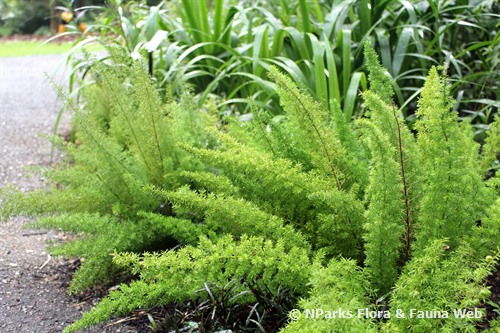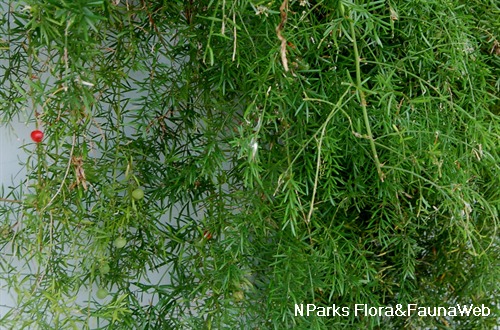
Back
Asparagus officinalis
| Family Name: | Asparagaceae |
| Synonyms: | Asparagus polyphyllus |
| Common Name: | Asparagus, 芦笋, 石刁柏 |
Name
Classifications and Characteristics
| Plant Division | Angiosperms (Flowering Seed Plants) (Monocotyledon) |
|---|---|
| Plant Growth Form | Shrub |
| Lifespan (in Singapore) | Perennial |
| Mode of Nutrition | Autotrophic |
| Plant Shape | Irregular |
| Maximum Height | 2 m |
Biogeography
| Native Distribution | Eastern Mediterranean, Europe, Caucasus and western Siberia |
|---|---|
| Native Habitat | Terrestrial |
| Preferred Climate Zone | Sub-Tropical / Monsoonal, Temperate, Highland / Montane |
| Local Conservation Status | Non-native (Horticultural / Cultivated Only) |
Description and Ethnobotany
| Roots | The root system is adventitious and the root type is fasciculated. |
|---|---|
| Foliage | True leaves are reduced to minute bract-like triangular brownish scales. |
| Stems | Young stem fleshy when when still underground; aboveground stem strongly branched, with fine, needle-like foliage(modified stems) in the axils of scale leaves. . |
| Flowers | Solitary or in pairs in the leaf-axils, unisexual, bell-shaped, greenish-white to yellowish with 6 tepals partially fused together at the base. |
| Ethnobotanical Uses | Food (Fruit or Vegetable): The tender young unexpanded shoots(spears) are eaten as vegetable. Medicinal: Asparagus has been highly valued and prescribed to stimulate and strengthen kidney function. In Asian medicine, asparagus root is given for cough, diarrhea, and nervous problems. Asparagus roots and leaves are used in Ayurveda medicine for female infertility. |
Landscaping Features
| Desirable Plant Features | Ornamental Foliage |
|---|---|
| Landscape Uses | Small Gardens, Container Planting |
| Thematic Landscaping | Economic Garden |
| Usage Hazard - Cons Remarks | The small red berry is poisonous to humans. |
Plant Care and Propagation
| Light Preference | Semi-Shade |
|---|---|
| Water Preference | Moderate Water |
| Rootzone Tolerance | Moist Soils, Well-Drained Soils |
| Maintenance Requirements | Moderate |
| Propagation Method | Seed |
Foliar
| Mature Foliage Colour(s) | Brown |
|---|---|
| Foliar Modification | Reduced / Needle-like, Scale-like |
| Mature Foliage Colour(s) Remarks | The green needle-like leaves are modified stems. |
Floral (Angiosperm)
| Flower & Plant Sexuality | Unisexual Flowers , Dioecious |
| Flower Colour(s) | Cream / Off-White, Yellow / Golden |
|---|
| Flower Grouping | Solitary, Cluster / Inflorescence |
| Flower Location | Axillary |
| Individual Flower Shape | Campaulate / Bell-shaped |
Fruit, Seed and Spore
| Mature Fruit Colour(s) | Red |
|---|---|
| Mature Fruit Texture(s) | Smooth, Glossy / Shiny |
| Fruit Type | Fleshy Fruit , Non-Accessory Fruit |
Image Repository
Others
| Master ID | 31537 |
|---|---|
| Species ID | 5936 |
| Flora Disclaimer | The information in this website has been compiled from reliable sources, such as reference works on medicinal plants. It is not a substitute for medical advice or treatment and NParks does not purport to provide any medical advice. Readers should always consult his/her physician before using or consuming a plant for medicinal purposes. |







.jpg)


